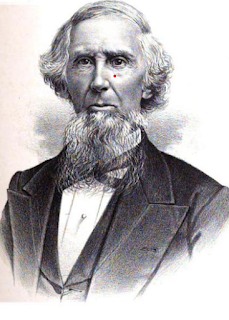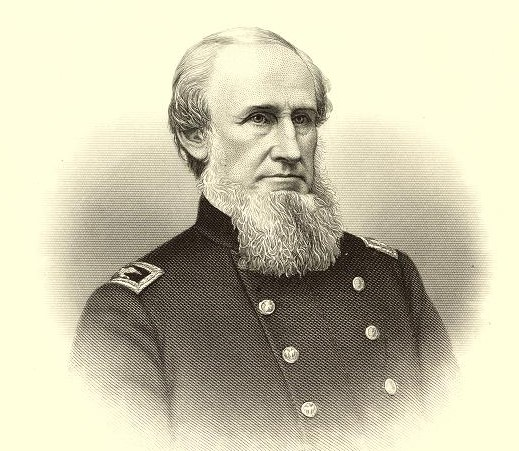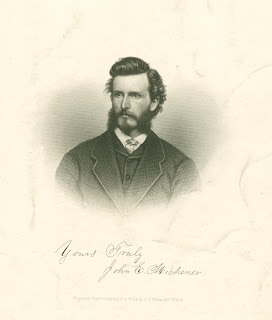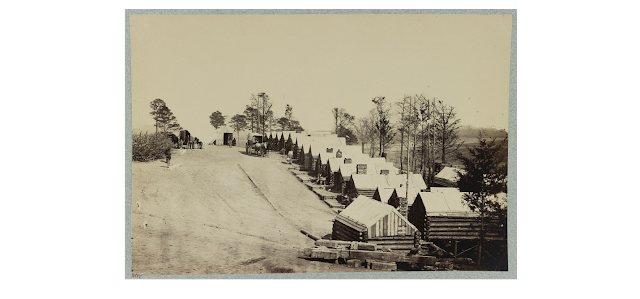 |
| Eli Crumrine Photograph Subject Files American Heritage Center, University of Wyoming Annals of Wyoming, Vol. 58, p. 13, 1986 |
One effect of the Civil War, an unbelievably bloody affair, is that it gave soldiers the opportunity to experience lands and peoples with whom they would otherwise have been unfamiliar. The men in the 85th Pennsylvania, for example, traveled across the south from Virginia to Georgia and back. If they survived, they came home more worldly (and perhaps haunted) than they otherwise would have been because of this experience.
This made it easier for many to move soon after the end of the war, often to the West to take advantage of settling on cheap farmland in states like Indiana or Nebraska. Many 85th veterans made the move to these and other states like Iowa, Missouri, Kansas. Some ventured to Oklahoma, Texas, the Dakotas and even farther away to the west coast. They were mainly young men in their 20's or early 30's in search of economic opportunity.
Only one member of the regiment settled in Wyoming, and he relocated there more than 20 years after the war ended. [Two other 85th soldiers had connections to Wyoming, which will be explored later in this article.] He was Eli Crumrine, a Civil War musician from East Bethlehem, Washington County, who enlisted at age 18 into Company B. His postwar journey for the far reaches of the United States came later in life when he was 43 years old. Crumrine was an established professional in banking for 20 years in western Pennsylvania with as a wife and three young children. However, his chose to head off for Laramie in Albany County, Wyoming where he spent the last 26 years of his life.
 |
| Boyd Crumrine Commemorative Biographical Record of Washington County (Chicago, 1893), p.209 |
 |
| Civil War Fife Player LOC |
The soldiers in Fort Lincoln, hearing what they thought was an attack cadence, nearly mistook the 85th for Confederates. From then on, the music provided by the musicians of the 85th conformed to military standards.
Besides sounding out camp orders, musicians also performed impromptu concerts in camp. [A list of Civil War marching songs can be found here.] The Kennedy Center website states that Civil War musicians could be divided into two general categories: field musicians and members of regimental bands.
"Field musicians included the fife-and-drum corps with the marching units and the buglers that accompanied both the cavalry and the infantry. These musicians marked the activities of daily wartime life, including wake up, lights-out, roll call, and drills. The music also helped organize the movement of the troops and even conveyed combat orders to soldiers, who were trained to recognize these commands..."
"Larger [regimental] bands performed as commanding officers inspected and addressed the troops; they would also present regular concerts and entertain soldiers in camp. The bands helped maintain morale and reinforce spirit and resolve. Musicians also did whatever was needed--staffed ambulances, tended wounded, and even fought as the war raged on."
 |
| Lemuel Thomas headstone Hampton (VA) National Cemetery Contributed by Ron Stewart findagrave.com |
The only wartime primary source we have from Eli is a letter he wrote home near the end of his three-year enlistment to a local newspaper describing camp polling numbers for the presidental election of 1864. It was the first time absentee voting was allowed. Some states like Pennsylvania allowed soldiers to vote in the field. Other states required the soldiers to return home in order to vote. Overall, the vote of soldiers was 4-1 in favor of Abraham Lincoln's re-election bid over George McClellan.
 |
| Pennsylvania soldiers voting in camp 1864 Harper's Weekly, 10-29-1864 |
So long after the war ended, why would an established middle-aged man pick up his family and move to a relatively remote part of the county?
 |
| Albany County (Wyoming) National Bank in Laramie Courtesy of Albany County Historical Society |
Eli took a trip to the West in 1885, the year before he made the move permanent, presumably to visit Laramie and get a feel for his future life. He discovered a remote yet growing community with beautiful vistas and plenty of opportunities to make money. Laramie, founded in 1868 as a boisterous railroad town, was undergoing significant growth at the time of Eli's arrival, from a population of 2,600 in 1880 to 6,400 ten years later. [Laramie has grown in every decade since then and today has a population today of over 30,000.]
 |
| Old Main, U. of Wyoming Built in 1886 LOC |
 |
| Robert P. Hughes Wyoming State Archives |
"I am almost ashamed to be one of the actors in the scene. But our greatest battles now are with the mosquitoes and Buffalo Gnats. They come down on us at all hours and they do not use either Modern Tactics or maneuver or logistics but seem to me to move in the old Roman Style by Phalanxes and they make us scratch our heads quite seriously to determine how to flank them."
"We have some peculiarities here. We have beautiful lightning every night, but we suffer for it in heat the next day. We have the most beautiful Sunsets I ever saw. The Sun will hide behind one of the Buttes and leave the whole western horizon a blace of fire." ["Loneliness, Sand and Sunsets: News from Ft. Laramie, August 13, 1867," Wyoming State Archives]
After the railroad arrived, a letter from a Laramie visitor to a friend in Pennsylvania in 1878 was typical in spreading word on this up-and-coming city.
 |
| 1882 Traveler's Railroad Guide |
"In the midst of these plains and on the south side of the Laramie river is the city of the same name. It is distant from Omaha 572 miles, altitude 7,123 feet. It contains a population of 2,500 souls. The only rolling mills in operation between the Missouri River and the Pacific Coast are located here...the Union Pacific Company has also extensive machine shops and round houses here...A public school house is nearly completed...There are some very handsome buildings, blocks and private residences built of brick and some large wholesale and retail business houses. Water is conveyed to the town through iron pipes from a spring 3 miles north of town."
"The Laramie Plains contain nearly 3,000,000 acres of winter and summer grazing lands....Over 40,000 head of stock are grazing this region...Most of the Ranchmen have from 640 to a couple thousand acres fenced...The ranch house that I am now writing from is genteel, nice and clean, three rooms carpeted and contains some nice walnut furniture. I merely state these facts for the reason that nearly all Eastern persons that have not visited the Stock Ranches of the Laramie Plains naturally suppose that they all sleep with loaded seven-shooters under their heads, a double-barreled shotgun in each corner of the house, and are regular devils and cuthroats." [Valley Spirit, Chambersburg, PA, October 23, 1878, p.2]
The writer of the above paragraph, Charles C. Clugston, moved to Wyoming within two years and with his business partner established a settlement near Laramie.
Financially, the move to Wyoming in 1886 was a wise decision for Eli Crumrine. He was the Albany County Bank's cashier for eight years and was then promoted to vice-president. He was able to acquire a ranch on the outskirts of town and had other holdings. His estate was worth well over $50,000 when he passed away 24 years later.
Crumine also played an active role in the growth of his new community. He helped arrange a donation from Andrew Carnegie 1902 to build a free county library in Albany (becoming a member of its board of trustees), was active the local Grand Army of the Republic of Union veterans and served for several terms in the Wyoming state senate.
Considering the 1,500 mile distance and arduous travel involved, it is noteworthy that Crumrine returned home to western Pennsylvania at least three times to attend regimental reunions, in 1890 and 1909, both in Uniontown, and in 1910 at Rogersville, Greene County.
 |
| 1910 Reunion of the 85th PA Rogersville, PA Courtesy of Greene Connections |
Unfortunately, Crumrine became ill with pneumonia on his way home from the 1910 reunion and died one day after returning to Laramie. His wife, Mary, traveled to Denver and accompanied him home on the last leg of his journey. Eli was a long-time asthma sufferer, but his health had improved in the summer months, allowing him to return to Pennsylvania for the reunion. He was 67 years of age when he died. He was succeeded at the Albany County Bank by his son-in-law, Charles Spalding.
 |
| Crumrine Home Courtesy of Albany County Historical Society |
 |
| Eli Crumrine Death Certificate |
The third member of the 85th PA regiment with a connection to Wyoming is Sergeant Marquis Lafayette "Mark" Gordon of Company G who hailed from Waynesburg in Greene County. The current governor of Wyoming is also named Mark Gordon. He is the great grandson of Marquis Lafayette Gordon.






















